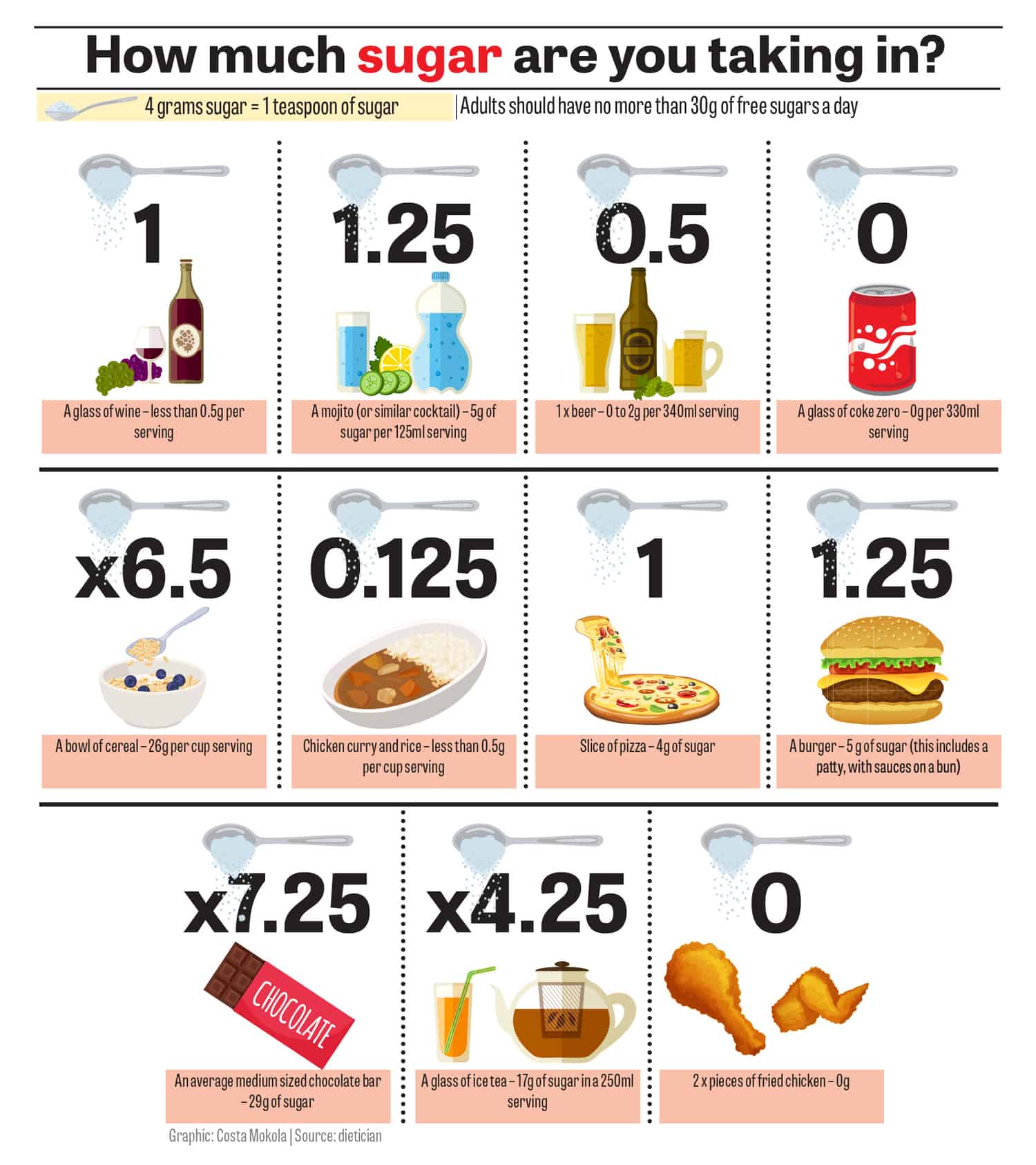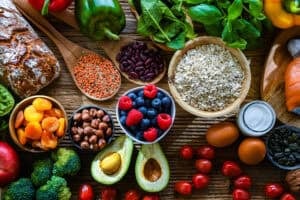Depending on flavours and brands, one cup of fruit juice can contain up to eight teaspoons of sugar.

While most South Africans know that items such as chocolates, sugary drinks, and a slice of cake are unhealthy, many may be blinded by products that are meant to be healthy.
There are many products that parade as ‘healthy’ which are actually harmful foods that contain as much sugar as ‘non-healthy’ products.
Kgadi Moabelo, registered dietitian and spokesperson for the Association for Dietetics in South Africa (ADSA), takes us through the journey of understanding how sugar may be lurking in what you consider the healthiest foods. So before you tuck in that bowl of cereal, you may want to read this.
So what is sugar and why is it so bad for you? Sugar is a simple carbohydrate, under the family of dietary carbohydrates. “We have the naturally occurring sugar that is found in fruits, vegetables, grains and other foods such as milk,” explains Moabelo.
And yes, there is something called a ‘good sugar‘: “We also have added sugar that is added as an ingredient into foods during processing and preparation, for example, during processing of bread and cereals, cakes, ice cream and many more. Therefore, it is often the naturally occurring sugar that is referred to as good sugar,” she says.
Many understand that sugar is the enemy but not many understand that sugar is in just about everything and therefore it is important to read food labels to see what you are eating.
Understanding healthy harmful foods
According to an article published by the US Food and Drug Administration (FDA) being able to read food labels is a skill “intended to make it easier for you to use the Nutrition Facts labels to make quick, informed food decisions to help you choose a healthy diet”.
Moabelo explains how to read food labels for this exact reason:
“On the food labels or the nutritional information, under carbohydrates, look for total sugars (measured in grams). There is a column indicated for a single serving and for 100g/ml serving. One can also look at the ingredient list and if sugar is indicated as the first ingredient in that food product, it is more likely to have high sugar. Ingredients are indicated in a descending order, starting with the greatest. Examples of sugars that can be found in products are cornstarch, corn syrup, corn sweeteners, maple sugar, honey and many more. At this stage in South Africa, whether sugar is naturally occurring or added, it does not reflect on the nutritional table, but rather on the ingredient list. Therefore, the total sugars include both natural and added.”
Understanding how many teaspoons of sugar you are consuming
On the nutritional information, under carbohydrates, if total sugar reads 10g, it means it provides approximately two teaspoons of sugar. Four grams of sugar is equivalent to a teaspoon. There is normally a column for “per 100g” and “per serving”. To check how many teaspoons of sugar you are consuming from a product, you divide the total sugar by four. For example, if the nutritional information of a 350ml can of a soft drink indicates 11g of sugar under the “per 100g” column and 39g of sugar under the “per serving” column, it means that if you drink 100ml of that drink, you would have taken just almost 3 teaspoons of sugar (i.e. 11g ÷ 4g = 2.8 teaspoons) and if you drink the whole 350ml, you would have taken 10 teaspoons of sugar (i.e. 39g ÷ 4g = 10 teaspoons).
Why are you craving something sweet?
Cravings are “consuming desires or yearnings” and observed more commonly in women than in men. They are also associated with pain relief. Cravings can come as a result of low blood sugar. “When one does not eat enough foods and/or skip meals, the sugar is the blood is bound to drop, subsequently leading to a craving. The body will be searching for a quick fix (that is, refined or simple carbohydrate such as a sweet). Some studies have reported that insulin resistance has also been linked with sweet cravings,” says Moabelo.
Additionally, a craving can occur with increased stress levels and low levels of serotonin, a hormone in the brain which controls mood, happiness, and also plays a role in appetite and sleep. This suggests that people respond to cravings to elevate their mood when faced with stressful circumstances. To control sweet cravings, one needs avoid skipping meals and ensure small meals are eaten frequently. Exercise also helps to improve serotonin levels and bring down the stress levels and thus elevate mood.

Foods to be aware of
Breakfast cereals – as it is a preference for most people in South Africa to eat cereals in the mornings, largely because of convenience, it is important to know that a wide variety of breakfast cereals such as corn flakes, instant porridges, granolas and many others, contain sugar, ranging from half a teaspoon to six teaspoons of sugar per serving.
Bread – some breads contain half a teaspoon per slice, meaning that if one eats two slices, they would have consumed one teaspoon of sugar.
Milk – half a cup (125ml) of either full cream or low-fat milk provides just over a teaspoon of sugar. The difference is not much when compared to fat-free milk, which provides almost a teaspoon.
Yoghurts – flavoured yoghurts, commonly bought in packs of six, religiously taken by children and adults as snacks, provide around a teaspoon to two of sugar per serving (100g) depending on the brand.
All Bran Hi-Fibre has over one teaspoon of sugar per serving (40g) and Special K has about one-and-a-half teaspoons of sugar per serving (40g).
Vitamin water – a 500ml of vitamin water contains roughly five teaspoons of sugar.
1 tablespoon of Chutney contains one-and-a-half teaspoons of sugar.
Most people believe that a 100% juice does not have a lot of sugar and therefore is beneficial for people with diabetes. Depending on flavours and brands, one cup of 100% juice contain five to eight teaspoons of sugar.
Mageu – South Africa’s loved non-alcoholic brewed mealie porridge contains one-and-a-half teaspoons of sugar per cup.
Wine – wine contains less sugar. Note that the sugar in wine is residual sugar from the grapes and not necessarily corn syrup or honey or granulated sugar. However, this does not mean that it is a good or bad beverage and must still be taken in moderation.
Can ‘0% sugar’ products be considered as healthy harmful foods?
When a product is labelled sugar free or 0% sugar, it does not necessarily mean it contains no sugar at all. It means the amount of sugar in that product is inconsiderable. Any product with less than 0.5g of sugar per serving can be labelled sugar free.
There are some controversies as to whether sugar substitutes are safe or not. Although a recent American study did not find these substitutes to cause any harm in moderate consumption, there are still doubts and concerns among users. Sugar substitutes are much better compared to regular sugar in that they do not form dental cavities and have reduced total calories which lessens the chance of weight gain. However, sugar alcohols that are also regarded as sugar substitutes can cause abdominal problems such as discomfort, gas, and diarrhoea especially when consumed in large quantities. Isomalt, lactitol, maltitol, xylitol, mannitol, and sorbitol are some of the sugar alcohols often used by manufacturers in various products such as chewing gums, jams, jellies, a variety of soft drinks and other beverages, as well as pharmaceutical products. Anybody using sugar substitutes must do so in moderation and not overuse them.
The big hitters
These are some of the products in South Africa with high sugar content. Please note that there is a long list of products with high sugar content and consumers must first check the food labels using the information provided in this article before purchasing, warns Moabelo.
| Food item | Amount of sugar (g) per 100g |
| Skittles sweets | 73g |
| Hot chocolate | 60g |
| Cadbury Top Deck | 59g |
| Otees Creme Soda | 38g |
| Strawberry Pops | 33g |
| Coco Pops | 33g |
| WeetBix Chocolate Bites | 32g |
Reference
- Jayadevan, A., Chakravarthy, D., Padmaraj, S.N., Raja, S.V., Bal, L. and Dimple, N., (2019). Dental caries and sugar substitutes: a review. J Dent Med Sci, 18(5), pp.13-23.
- Koen, N., Blaauw, R. and Wentzel-Viljoen, E., 2016. Food and nutrition labelling: the past, present and the way forward. South African Journal of Clinical Nutrition, 29(1), pp.13-21.
- Macedo, D.M. and Diez-Garcia, R.W., 2014. Sweet craving and ghrelin and leptin levels in women during stress. Appetite, 80, pp.264-270.
- Rolfes, R.P., K. & Whitney, E. (2006). Understanding normal and clinical nutrition, pp.55 – 139.
- Yanovski, S., (2003). Sugar and fat: cravings and aversions. The Journal of nutrition, 133(3).
Kgadi Moabelo is a dietician with special interest in weight management, hypertension and diabetes mellitus. She is passionate about nutrition and fitness






